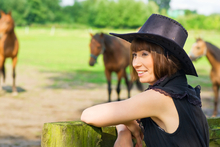To qualify as truly healthy, an equine needs to be more than physically well; the truly healthy equine must also have a good temperament and be mentally stable without stereotypies that threaten a wholesome relationship between owner and horse. The same can be said about a truly healthy horse person.

Encouraging a true partnership between horse and human
In addition to physical health, the truly healthy equine must have a good temperament and be mentally stable and the same can be said about a truly healthy horse person.
In the first chapter of Anna Sewell's novel, Black Beauty, the equine mother admonishes her son, "I hope you will grow up gentle and good, and never learn bad ways; do your work with a good will."
Later Black Beauty is warned "There are a great many kinds of men; there are good and thoughtful men; but there are bad, cruel men; there are a great many foolish men, vain, ignorant and careless, who never trouble themselves to think; but I will say, do your best, whatever it is, and keep up your good name."
Good health is defined as being of "sound physical and mental condition," and "healthy" is defined as, "Enjoying a balanced physical and mental state of well-being." Certainly, these definitions apply to horses, as well as to humans.
In the human/equine relationship, recognizing a healthy horse and keeping that horse healthy and sound is a key responsibility. That said, a healthy person with a positive, thoughtful temperament who is gentle, good and well versed in good horsemanship will most likely bring out the healthy traits in any equine.
One horse trainer that many admire and respect, including the Queen of England, is Monty Roberts who has made his life all about horses. Early in his life he witnessed horses being "broken" by violent, traditional methods that he came to question as a young man who truly cared about horses.
Often expressing the idea that he has one major goal in life and that it is to leave the world a better place for horses, Monty uses his energy and enthusiasm to not only train horses, but also to demonstrate to people, the importance of listening to and learning from horses.
Monty first learned to listen to horses while observing wild mustangs in Nevada at the age of thirteen. Sent there to round up horses for the Salinas Rodeo Association's Wild Horse Race, he spent hours silently watching the feral horses interact with each other.
He soon realized that the wild horses used a discernable, effective and predictable body language to communicate, set boundaries, show fear and express annoyance, relaxation or affection.
In a moment that would change his life and the lives of horses and people forever, Roberts understood that utilizing this silent language would allow training to commence in a much more effective and humane manner, encouraging true partnership between horses and humans.
Many factors make one horse better than the other, and every horse is different, but in the end, a healthy horse is a good horse and when a truly healthy horse person works with a truly healthy horse, good things happen.
